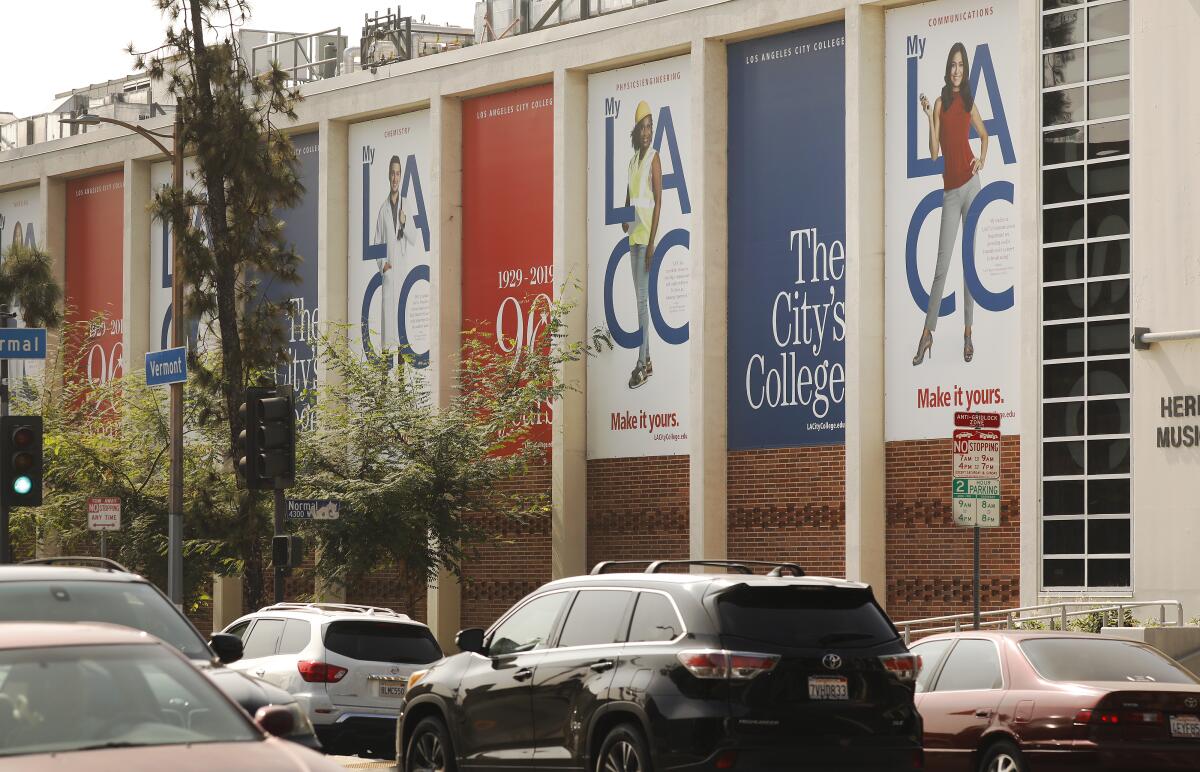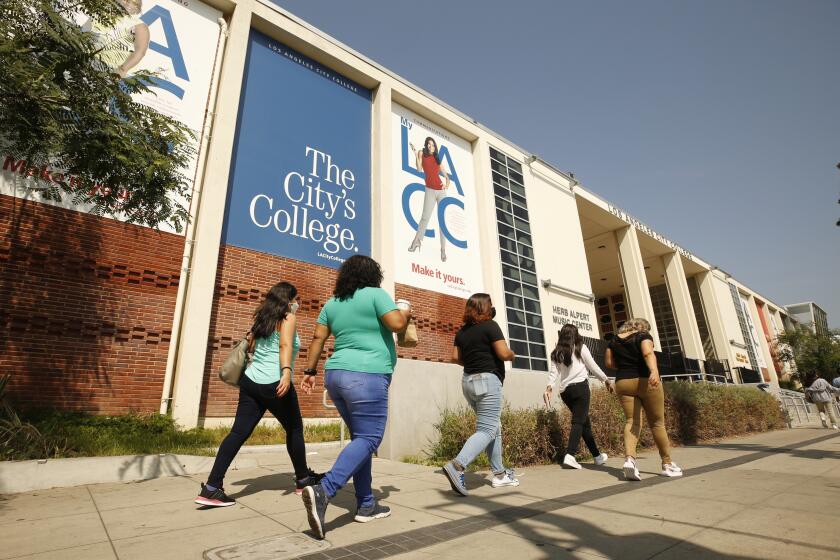1.2 million fake students applied to California community colleges last year. What’s being done?

- Share via
- Financial aid fraud has been on the rise in California’s community colleges.
- Scammers stole roughly $8.4 million in federal financial aid and more than $2.7 million in state aid in 2024.
California community college officials are working to overcome a serious predicament involving hundreds of thousands of fake students and hefty financial aid losses.
It’s possible this multimillion-dollar problem could be solved, in part, with a $10 fee.
At a meeting last month of the Board of Governors of the California Community Colleges, officials discussed a proposal to charge prospective students a $10 application fee — applying to one of the state’s 116 community colleges has historically been free.
As officials prepare to put into place measures to prevent fraud, the charge is one more possible way to weed out those who are gaming the system to steal millions in financial aid dollars. At the May 20 meeting, the proposal seeking approval to explore the implementation of a “nominal” application fee was met with lengthy and spirited debate — with some fearing the fee would be seen as an obstacle for new students, many of whom are low-income.
But the severity and volume of the fraud have caused the chancellor’s office to consider the charge, which would represent a fundamental change from the system’s open-access model.
How are fraudsters scamming the system?
Of those who applied to state community colleges from January through December 2024, 31% were determined to be likely fraudulent. That’s more than 1.2 million applications, according to data from the office of the chancellor for the college system.
Anyone who applies to a California community college is admitted. This accessibility, coupled with the increase in remote and hybrid formats for classes since the COVID-19 pandemic, creates vulnerabilities that scammers exploit to cash in on both state and federal financial aid.
Fraudsters, with the help of stolen identities, bots and artificial intelligence, act as dozens or even hundreds of students. They join classes and remain enrolled until they receive their financial aid checks. The fake students often take up limited spots in classes actual students need to take, creating headaches for both students and staff.
Although any financial aid goes toward tuition first, low-income community college students pay little or no tuition in California, meaning they receive funds directly to use for books, housing, food or other needs while they’re in school.
Some fraudsters have spent that cash on plastic surgery, elaborate vacations and designer bags, federal officials say.
How much aid is going to fake students?
The state’s community colleges have seen a steady increase in fraudulent applications and enrollment in recent years. In 2022, The Times reported that 20% of recent traffic on the main portal for online applications was malicious and bot-related, meaning that by early 2025 — in less than three years — such traffic jumped by more than 10%.
California officials and community college staff have uncovered what is believed to be one of the state’s largest college financial aid scam attempts.
Although 31% of applicants were deemed likely fraudulent last year, that doesn’t mean 31% of students in the community college system are fake, noted John Hetts, the executive vice chancellor for research, analytics and data for California Community Colleges.
Hetts emphasized to The Times earlier this year that those fraudulent applicants were detected and then shut out of the system, preventing them from enrolling and stealing financial aid.
Officials said individual campuses’ improvements in detecting fraud had increased the percentage of fake applications that were stopped — but there have also been more attempts.
The around 30% of applicants that were probably fake in 2024 represent about 85% of fraudulent attempts, according to Chris Ferguson, the executive vice chancellor of finance and strategic initiatives, who spoke at last month’s Board of Governors meeting.
Data from the chancellor’s office show that about $8.4 million in federal aid and $2.7 million in state aid were stolen by scammers in 2024.
A professor at Pierce College has spent months searching for fake students who are enrolled in classes.
That’s only a “very, very small percentage” of total aid that’s disbursed at California’s community colleges, according to officials from the chancellor’s office. In 2024 through 2025 to date, students received roughly $2 billion in total aid from all federal sources, including loans and Pell Grants, and about $1.5 billion in state aid, the officials said.
From January through mid-April of this year, $4 million in federal aid and more than $760,000 in state aid have been disbursed and written off as fraud by California community colleges, according to chancellor’s office data.
With more than 2.1 million students who collectively receive billions in aid, Hetts said his office was “fairly proud” of its record.
“We can absolutely get better. There’s no question. Any dollar we lose, we don’t want to lose that dollar, but we are fighting really hard,” he said, and the “vast majority of attempts” are stopped.
What’s being done to stop the scams?
Officials at the chancellor’s office said they couldn’t share the specific mitigating measures they had put into place to detect and prevent application, enrollment and financial aid fraud, but they said they were undertaking a “complete redesign” of the application system.
The new system, which they hope to roll out by spring semester 2026, will have integrated fraud detection tools. Ferguson said if fraudsters are stopped at the application stage, it would have a “downstream impact” of preventing enrollment and financial aid fraud.
Jason Williams, an assistant inspector general at the Department of Education’s Office of Inspector General, said financial aid fraud is not a new phenomenon; neither is it exclusive to California. His office investigates fraud rings across the country that specifically target community colleges for their lower tuition costs, which means scammers can collect a larger chunk of leftover financial aid dollars compared to a more expensive school.
But “as we change and close loopholes, they find new ones,” Williams said. “We have to make sure that we’re evolving with the fraud and make sure we’re keeping up with what’s going on so we can continue to be effective.”
Williams said the fight against fraud could become more challenging as the Trump administration attempts to dismantle the Education Department. Mass layoffs at the department were blocked in May by a federal judge. The Trump administration then asked the Supreme Court earlier this month to leave the layoffs in place.
The department’s Office of Inspector General has not been affected by layoffs, but it has lost about 20% of its workforce since the beginning of the fiscal year last fall due to deferred resignations and voluntary buyout programs that were offered to all federal employees when Trump took office, officials said.
That decrease in staffing is having a noticeable impact, Williams said, especially as the federal hiring freeze is preventing the team from filling crucial roles.
Amid the layoff turmoil, the workload will likely increase for the department as it institutes a new procedure to combat fraud.
The Education Department announced earlier this month it’s implementing a new rule that would require financial aid applicants to present, either in person or in a live video conference, an unexpired, valid, government-issued photo identification to their school, and the school must preserve a copy. The change will go into effect in the fall, and in the interim, colleges will have to validate the identity of certain first-time applicants who are enrolled in the summer term.
“When rampant fraud is taking aid away from eligible students, disrupting the operations of colleges, and ripping off taxpayers, we have a responsibility to act,” Secretary of Education Linda McMahon said in a news release announcing the change.
Several California community colleges have reported an onslaught of enrollment attempts by bots in what may be a scam to gain financial aid or an effort to probe the system’s online vulnerabilities, California Community Colleges Chancellor Eloy Ortiz Oakley said.
As for the creation of a $10 application fee at California’s community colleges to combat fraud, it’s a “potential consideration and not a foregone conclusion” for now, a spokesperson for the chancellor’s office told The Times. Any new fee must be authorized by state statute.
Staff at the chancellor’s office said they are not trying to create an obstacle for hopeful students, just hoping to put up an additional barrier for fraudsters.
The fee is not being discussed as a potential revenue source, and officials said it could potentially be waived, refunded or credited to students with demonstrated financial hardship.
There was “great deliberation” over the fee at the May board meeting, said Jory Hadsell, an executive at the chancellor’s office focused on strategic technology initiatives, “but also a sense that we need to move with urgency to safeguard the access for all of our students.”
The system now works with the IT security company ID.me to help verify identities of applicants. But at the individual college level, staff and faculty have become familiar with the process of determining whether their students are real by checking for “authentic engagement” in classes, according to Hetts from the chancellor’s office.
They’re also more familiar with some of the tricks fraudsters try to pull. One person attempting to enroll in the L.A. Community College District came to an in-person meeting to verify their identity and presented a California driver’s license with the weight listed in kilograms, said Nicole Albo-Lopez, the deputy chancellor of LACCD.
Examples like this remind her that although the students in these schemes — filling up classrooms and stealing taxpayer dollars — are not real, the people behind the scams are.
“This isn’t just a computer or a robot out there,” Albo-Lopez said. “These are real people that are committing these crimes, and technology has been weaponized to attack other sectors. Higher education just happens to be the one they’re focused on right now.”
More to Read
Sign up for Essential California
The most important California stories and recommendations in your inbox every morning.
You may occasionally receive promotional content from the Los Angeles Times.

















